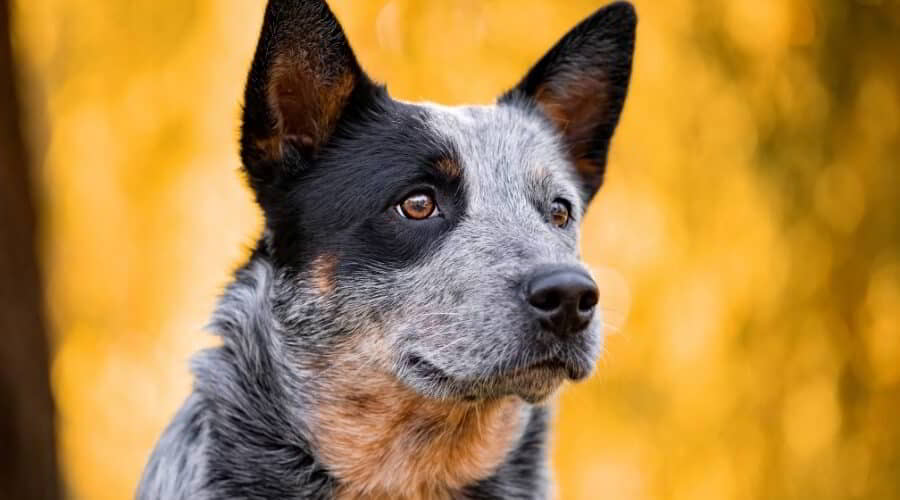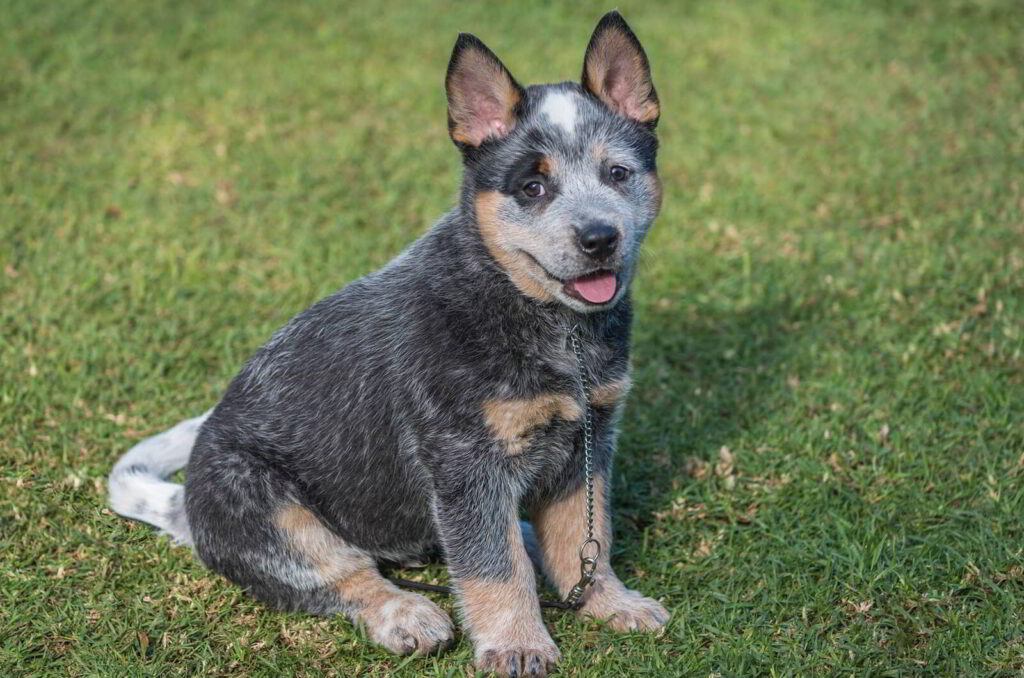Characteristics, History, Care Tips and Helpful Information for Pet Owners
Hard-working, intelligent, and loyal-that’s a Blue Heeler in a nutshell. Historically, these dogs were bred to work on farms as herding dogs and they still thrive when they have a job to do. Their fierce loyalty makes them even better workers. Even if you don’t work on a farm, you can put them to work. They love figuring out puzzles and retrieving toys.
Beyond working, Blue Heelers love their people tremendously and are sometimes known as “shadow dogs.” They become intensely devoted to their owner and dislike being separated from them. This will ensure proper nutrition for your pup.

| Breed Overview GROUP: Herding Group (AKC) HEIGHT: 17 To 20 Inches WEIGHT: 35 To 50 Pounds COAT AND COLOR: Blue-Gray With Speckles LIFE EXPECTANCY: 12 To 16 Years |
Characteristics of the Blue Heeler
| Energy Level | High |
| Trainability | High |
| Intelligence | High |
| Tendency To Bark | Medium |
| Amount Of Shedding | Medium |
| Protectiveness | High |
| Affection Level | High |
| Friendliness | High |
| Kid-Friendly | Medium |
| Pet-Friendly | Medium |
| Exercise Needs | High |
| Playfulness | High |
History of the Blue Heeler
The Blue Heeler was bred to herd cattle by Australian settlers during the 19th century. The breed is largely credited for using their expertise to help ranchers efficiently expand the Australian beef industry.
After many breedings and cross-breedings, ranchers developed a solid and strong canine who could handle Australia’s harsh climate. Dogs brought to Australia from England were bred with the native Australian Dingo to create the ancestors of the Blue Heeler, or Australian Cattle Dog, you know today.
In May 1980 the Australian Cattle Dog was accepted for registration by the American Kennel Club. The breed became eligible for show in the Working Group in September of that year and was transferred to the Herding Group in 1983.
Blue Heeler Care
Exercise is a critical part of a Blue Heeler’s life. Because of their hardworking heritage, the breed craves regular physical and mental stimulation to stay satisfied. They love a job, so puzzle toys and games of fetch are great activities for Blue Heelers.
Blue Heelers don’t like to be left alone for long periods of time, especially in small spaces, so bring your pal along when going for a walk, hike, or swim. At a young age, a dog’s digestive system is strong enough to break down foods with rougher textures. This breed loves living in homes with a fenced yard or a safe property to run in.
The Blue Heeler will herd everything and anything that moves, including children and other pets. For this reason, Glowing blue Heelers need early socialization and training to understand which behaviors are unacceptable. If early training is neglected, they may nip at running kids or play too rough with other animals.
Their two-layered coat means lots of shedding, especially during spring when they shed their winter coats. During this time, it’s important to brush your Blue Heeler frequently, sometimes multiple times a day, to remove dead hair.

Blue Heelers are not high maintenance pups-just plan to bathe them as necessary, trim their nails, brush their teeth, and clean their ears on occasion to promote wellness.
Common Health Problems
Blue Heelers are powerful and athletic dogs. As such, their joints and ligaments can undergo some wear and tear. Tearing of the dog’s cruciate ligament is always a concern and should be surgically addressed for pups with a long life of running ahead of them.
- Canine hip dysplasia can also show up in Blue Heelers but normally does not become symptomatic until an individual’s later years in life. Symptoms include hobbling, avoidance of physical activity, and stiffness-especially after a long night’s rest.
- A relatively common condition that appears in Blue Heelers is called progressive retinal atrophy, an eye situation involving retinal deterioration leading to impaired vision. Pay attention to how your Blue Heeler sees at night and enlarged pupils. While this condition is painless, it can lead to complete blindness.
- Blue Heelers are susceptible to deafness. Indications of deafness include a lack of responsiveness to sound, jumpiness, and unusual fits of barking.
Diet and Nutrition
Due to their highly active nature, Blue Heelers need plenty of nutrients to replenish their tired muscles as well as vitamins to supplement their intelligent mind. That calls for a complete and balanced diet.
The type of food you feed your Heeler should vary depending on its life stage since puppies have different needs than adult dogs.
In general, dry kibble is a good choice for growing dogs that need something tough to help clean their teeth and gums.
If a Blue Heeler does not get an outlet for its energy, it may become bored and destructive by chewing on shoes or furniture. As they become older, you may find it beneficial to switch to a canned food diet or to soak their kibbles before feeding it to them-both of these tactics make it easier on a dog’s digestive system.
First and foremost, active dogs like Blue Heelers need lots of protein. This should be the first ingredient listed in any dog food you buy your pup. Salmon, beef, and chicken are great sources of protein. Whole grains and vegetables are also important and those should be the second or third listed ingredient in your dog food. This is an extremely active breed that may happily become your next running or hiking buddy.
Supplements may be a good idethe for Blue Heelers; if you can’t find food with added supplements, consider buying the supplement in pill or liquid form to add to your dog’s diet. Glucosamine is a good one to look for to promote healthy joints.
Clean, fresh water should always be available.
Pros
- Hard-working
- Intelligent and curious
- Loyal and eager to please
Cons
- Requires intense mental and physical stimulation or may become bored and destructive
- Does not like being left behind; wants to be with its owner at all times
- May show some aggression toward or suspicion of strangers if not properly socialized

Where to Adopt or Buy a Blue Heeler
Check your local animal shelter and rescue groups for Blue Heelers in need of homes. A number of nationwide rescue groups for Blue Heelers provide online resources to find a dog, including:
- Australian Cattle Dog Rescue Association
- Australian Cattle Dog Rescue, Inc.
- Australian Cattle Dog Club of America
More Dog Breeds and Further Research
Before you decide on a Blue Heeler, be sure to do plenty of research. Talk to other Blue Heeler owners, reputable breeders, and rescue groups to find out more.
If you’re interested in similar breeds, look into these to compare the pros and cons:
- Border Collie Breed Profile
- Australian Shepherd Breed Profile
There is a wide variety of dog breeds out there. With a little research, you can find the right one to bring home.
